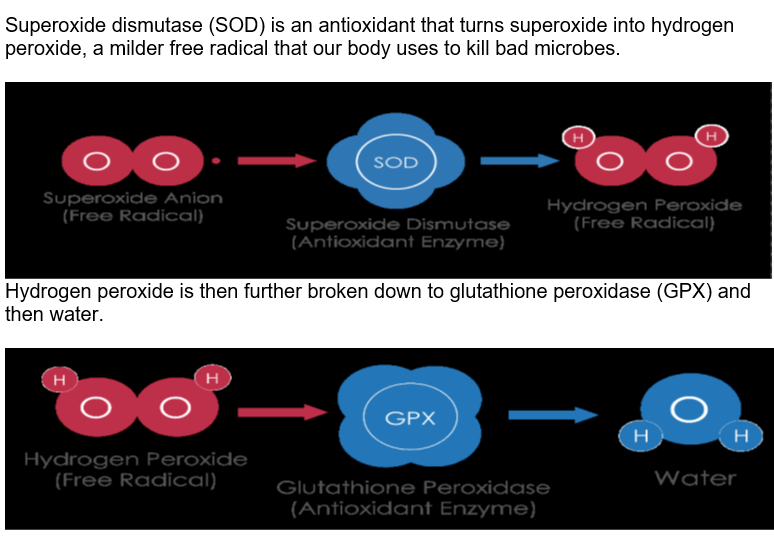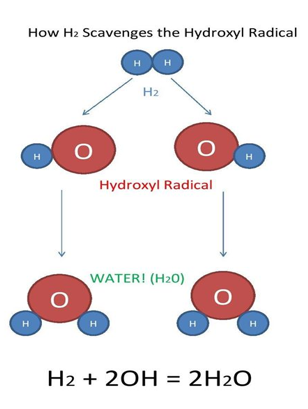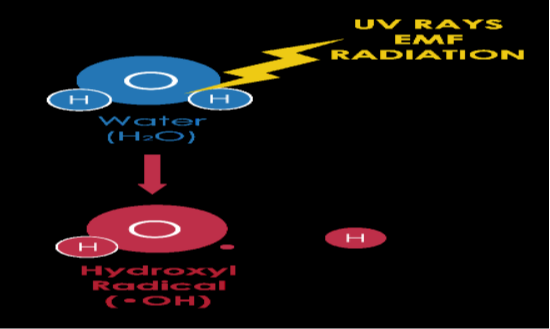Oxidation/Reduction and Free Radicals
Oxidation and reduction are two opposing forces in chemistry. Oxidation is the loss of electrons and reduction is receiving electrons. One can remember this by the pneumonic OILRIG (oxidation is losing, reduction is gaining). This idea in chemistry becomes important when thinking about free radicals. Most free radicals are the byproduct of energy production in the mitochondria of our cells. Much like the exhaust of a car upon combustion of gasoline to give a car energy, we generate free radicals constantly in the aftermath of creating energy in the form of ATP in the engine of our cells (mitochondria) that can stifle the energy and detoxifying processes in our body. Also like a car, the mitochondria use oxygen to produce energy in the mitochondria. However, a small amount of that oxygen (about 2-4%) is converted into a free radical called superoxide. Antioxidants are antioxidation chemicals that have electrons to donate, (go through reduction) and most times do so without they themselves becoming a free radical itself.

However, you need two molecules of GPX to neutralize one hydrogen peroxide molecule. It isn’t hard to see that if you don’t have enough SOD and GPX, then there is a buildup of superoxide and hydrogen peroxide. The biggest problem occurs if the superoxide and hydrogen peroxide interact with each other to form a much more dangerous and toxic free radical called Hydroxyl Radical. If superoxide combines with Nitric Oxide it produces another dangerous and toxic free radical called Peroxynitrite. Incredibly, one H2 molecule neutralizes two molecules of Hydroxyl Radical or Peroxnynitrite and turns both into two molecules of water!

Additionally, electromagnetic radiation and ultraviolet rays can turn water in our body into Hydroxyl Radicals. Hydroxyl Radicals are so highly reactive that it can steal electrons from any molecule around them including DNA, proteins and lipids that make up your cells. This can cause acute and chronic illness.

Final Thoughts
Long term free radical damage also called oxidative stress has been linked to premature aging and chronic diseases such as cancer, diabetes, neurodegenerative diseases, cardiovascular disease and acute illness’ such as pneumonia, influenza, allergies, and nephritis. An interesting study of Japanese centenarians (person who is over 100 years old) showed that their breath molecular hydrogen levels were up to 4x higher than the average healthy person. It is too early to say but since H2 has been shown to help with brain edema and reduction of tau protein expression in Alzheimer’s, that it may be useful for autism too.
Most people associate hydrogen gas with the Hindenburg disaster, but this therapy is a very small dose of hydrogen gas dissolved in water making it completely safe. In fact, NASA has done research with astronauts drinking hydrogen infused water to protect them against radiation exposure in space. Most of the studies using molecular hydrogen H2, used a dissolvable molecular hydrogen tablet to capture the gas in the water. Researched Nutritionals has such a product that I have in my office and I have seen some patients benefit from it with symptoms of brain fogginess. These 60 tablets ($45.00) provide about 1.5 ppm (parts per million) of H2 in an eight-ounce glass of water.
Fun facts: If each molecular hydrogen were a penny, one teaspoon of this water contains enough H2 (pennies) to fill 333,000 football stadiums with pennies. Another incredible fact is you could put 3 million molecules of H2 across the width of a human hair!
There are also multiple companies selling online hydrogen generating devices to make your own hydrogen water at home. These units cost anywhere from 75.00 – 2000.00 dollars. It is recommended that you start with filtered water, and they advertise that there will be anywhere from 500-1000 ppb after hydrogen is generated either through ionization or direct hydrogen infusion. Keep in mind that 500 ppb (parts per billion) is only .5 ppm or one third of 1.5 ppm (parts per million). I am reviewing these devices and considering one for myself but it takes a little research to evaluate price and quality of these devices. There are also devices to inhale H2 gas and this too costs thousands of dollars.
Dissolvable H2, molecular hydrogen is a new and novel approach to treating oxidative stress and all the problems that are associated with it. I am intrigued with the research and will be looking at this as an important consideration for those who may benefit from it.